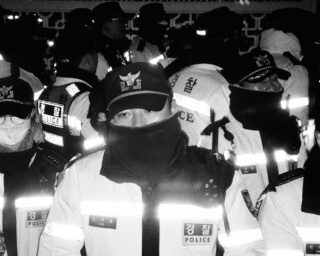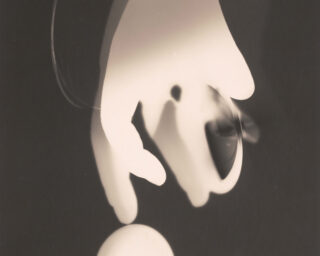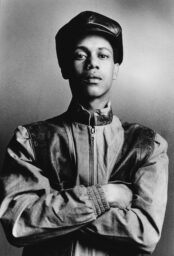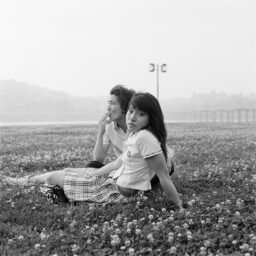Roaming Without End

Henk Wildschut, Ville de Calais, 2016
© the artist
Everything about In Between (En suspens) is understated—except its politics. This group exhibition at LE BAL in Paris presents an outstanding slice of regionally diverse contemporary documentary projects. The show forgoes facile conclusions about the state of our visual culture, our politics, our failings and blind spots. Instead, it opts for a poetic, peripatetic tour without beginning or end.
Featuring thirteen artists from the United States, Africa, and Europe, In Between is a willingly unfinished and incomplete cartography of the most burning issues in documentary aesthetics today: the place of fiction in a medium feeding on reality; the place and function of the museum; the use of computer-generated imagery; the relevance of old-school photojournalism; and the overall political impotence of film and photography in an age that is oversaturated not only with images but also with autonomous image-making technologies. In Between lacks a central curatorial narrative; instead, it activates the visitor to forge links between the individual works. The catalogue, through its black-and-white reproductions and softcover binding, lacks the authoritative appearance and tone of the usual weighty tome accompanying shows. Instead, this ephemeral quality contributes to the ambiance of open-endedness of the exhibition.

Debi Cornwall, Welcome to Camp America: Inside Guantánamo Bay, from the series Beyond Gitmo, 2017
© the artist and Steven Kasher Gallery, New York
The exhibition spaces have been filled to capacity with photography, video, and prints, but nowhere does it feel overcrowded. Politics hover constantly above the artworks; In Between provides a map of post-9/11 conflict from a western as well as eastern perspective. Debi Cornwall’s impressive Beyond Gitmo shows former prisoners of the Guantánamo Bay detention center. Her large photographs are supplemented with short texts factually but tragically informing us how long they have been detained. Cornwall’s work maps ruined lives in times of perpetual war and failing international politics. Kurdish artist Hiwa K, in View from Above, shows the inhumanity of bureaucracy confronting asylum-seekers. Using computer-generated imagery based on the real-life statements of “M,” Hiwa K reconstructs a war zone, detailing a city “M” claims to be from to obtain refugee status. Fact and fiction entangle in a manner that leaves visitors wondering what the limits of both are in the context of documentary photography.

Hiwa K, still from View From Above, 2017
© the artist, KOW, Berlin and Prometeo Gallery di Ida Pisani, Milan
Henk Wildschut’s Ville de Calais perfectly illustrates the understated yet highly political nature of In Between. Wildschut photographs the subsequent construction, dilapidation, and removal of a refugee encampment in the dunes of Calais, a French border city. The improvised camp, deemed a symbol of the failure of European immigration policy and an affront to the supposed humanism of the European Union, harbored a handful of immigrants wishing to cross the channel to England in 2015, but reached thousands of inhabitants by the time it was dismantled at the end of 2016. Wildschut’s series, of which only a small selection is presented, shows the rise and fall of this micro-civilization: from early, primitive dwellings to a community with churches, mosques, grocery stores, and various competing neighborhoods. Between the appearance and disappearance of the camp, as if it were a natural process, we must imagine the lives of the people living in this landscape of decay.

Mélanie Pavy, still from Go Get Lost, 2018
© the artist
One important theme of In Between is surveillance and control. What is the role of visual artists vis-à-vis commercial and state apparatuses doing part of the artist’s job: mapping, showing, representing, and interpreting? Former Magnum photographer Luc Delahaye’s video installation Eyal Checkpoint was made with a smartphone filming a seemingly endless stream of Palestinians crossing into Israel to work. The mechanical sound of the turnstiles combined with the flux of fast-appearing and disappearing faces becomes unbearable if we consider the politics behind this seemingly quotidian event. Another work, a promotional video for a Chinese company, shows the state-of-the-art application of fully automated mining in a plethora of databases coupled with real-time facial recognition, thus entering into a dialogue with Delahaye’s more observational use of surveillance. Human agency seems to be rarer in today’s world, humans instead becoming the targets of the technology we invented.

Sebastian Stumpf, still from Puddles, 2013
© the artist and Galerie Thomas Fischer, Berlin
In Between walks in step with our time: our love-hate relationships with states of in-betweenness, with not knowing who we are, where we are going, and where our culture is headed. In short, in a time that is profoundly felt to be without direction, In Between does not provide answers but instead shows diverse routes in documentary practices that shed light on our culture at the crossroads. Our task is to actively engage with and navigate through this brave new world.
In Between (En suspens) is on view at LE BAL, Paris, through May 13, 2018.


























